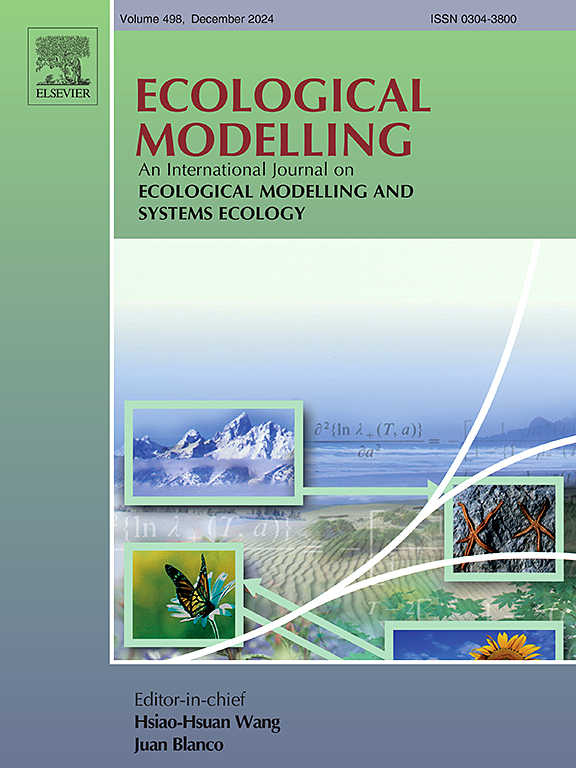在能源和化学工业领域建立基于生态系统服务的生态网络
IF 2.6
3区 环境科学与生态学
Q2 ECOLOGY
引用次数: 0
摘要
人类对化石能源的大量利用促进了社会经济的发展。但同时也产生了严重的区域生态环境问题,包括水资源短缺、水土流失、土地荒漠化等。为了平衡经济发展与生态环境的刚性约束,实现区域的可持续发展,必须对生态环境受损区域进行基于生态网络的优化调控。我们利用黄河中上游能源化工区的遥感、气象、土地利用和土壤数据,应用 InVEST、CASA 和 RWEQ 模型对相关生态系统服务(ES)进行了定量评估。此外,我们还构建了由生态源区、阻力面、廊道和节点组成的生态保护网络。研究结果如下。首先,从 2000 年到 2020 年,耕地和未利用地面积减少,但森林、草地、水体和建设用地面积增加。在空间分布上,草地所占比例最高,其次是未利用地,其他类型土地所占比例相对较低。其次,从 2000 年到 2020 年,所有生态系统服务要素和整体生态系统都有所改善。然而,ESs 表现出明显的空间异质性(即东南部好于西北部)。第三,比较最小累积阻力(MCR)模型和回路模型构建的两种生态网络,基于 MCR 的生态网络因其较高的ε、θ 和 σ 值而被认为更好。稳健性分析也表明,基于 MCR 的生态网络更加稳定。最后得到的生态源面积为 110,300 平方公里,占研究区域面积的 21.69%。研究区域西北部的沙漠地区生态阻力相对较大,而东南部则相对较小。提取了 59 条生态廊道(包括 31 条重要廊道)和 22 个生态节点。最终确定的生态网络呈菱形,研究区域东、南、西、北四个方向的生态源区紧密相连。为促进研究区域的空间优化,必须采取适当的措施(如植树造林和土壤改良),以减少区域生态状况的失衡,提高生态系统功能和景观连通性,减少各种阻力,最终促进保护成果。本文章由计算机程序翻译,如有差异,请以英文原文为准。
Building ecosystem services-based ecological networks in energy and chemical industry areas
The massive utilization of fossil energy by humans has promoted socio-economic development. However, it has also generated severe regional eco-environmental problems, including water shortage, soil erosion, and land desertification. An optimal ecological-network-based regulation of eco-environmentally damaged areas is necessary to balance economic development with rigid eco-environmental constraints in pursuit of sustainable regional development. Using remote-sensing, meteorology, land use, and soil data of energy and chemical industrial areas in the mid-upper reaches of the Yellow River, we quantitatively evaluated the related ecosystem services (ESs) by applying InVEST, CASA, and RWEQ models. Additionally, we constructed ecological conservation networks comprising ecological source areas, resistance surface, corridors, and nodes. The results are as follows. First, from 2000 to 2020, the areas of cultivated and unused land decreased, but those of forest, grassland, water bodies, and construction land increased. Regarding spatial distribution, the proportion of grassland was the highest, followed by unused land, and other types of land accounting for a relatively low proportion. Second, from 2000 to 2020, all ESs and the overall ecosystem improved. However, ESs demonstrated a clear spatial heterogeneity (i.e., better in the southeast than in the northwest). Third, comparing the two ecological networks constructed by minimum cumulative resistance (MCR) and circuit models, the MCR-based ecological network was considered better because of its higher ε, θ, and σ values. Robustness analysis also showed that the MCR-based ecological network was more stable. Finally, ecological source areas of 110,300 km2 were obtained, accounting for 21.69 % of the study region. Ecological resistance was relatively high in desert areas, which are to the northwest of the study region, and relatively low in the southeast. Fifty-nine ecological corridors (including 31 important ones) and 22 ecological nodes were extracted. The finalized ecological network was diamond-shaped, with the ecological source areas in four directions (i.e., east, south, west, and north) of the study region being closely connected. To promote the spatial optimization of the study region, appropriate measures (e.g., afforestation and soil improvement) must be taken to reduce regional imbalance in ecological condition, improve ecosystem functions and landscape connectivity, reduce various resistance, and ultimately promote conservation outcomes.
求助全文
通过发布文献求助,成功后即可免费获取论文全文。
去求助
来源期刊

Ecological Modelling
环境科学-生态学
CiteScore
5.60
自引率
6.50%
发文量
259
审稿时长
69 days
期刊介绍:
The journal is concerned with the use of mathematical models and systems analysis for the description of ecological processes and for the sustainable management of resources. Human activity and well-being are dependent on and integrated with the functioning of ecosystems and the services they provide. We aim to understand these basic ecosystem functions using mathematical and conceptual modelling, systems analysis, thermodynamics, computer simulations, and ecological theory. This leads to a preference for process-based models embedded in theory with explicit causative agents as opposed to strictly statistical or correlative descriptions. These modelling methods can be applied to a wide spectrum of issues ranging from basic ecology to human ecology to socio-ecological systems. The journal welcomes research articles, short communications, review articles, letters to the editor, book reviews, and other communications. The journal also supports the activities of the [International Society of Ecological Modelling (ISEM)](http://www.isemna.org/).
 求助内容:
求助内容: 应助结果提醒方式:
应助结果提醒方式:


